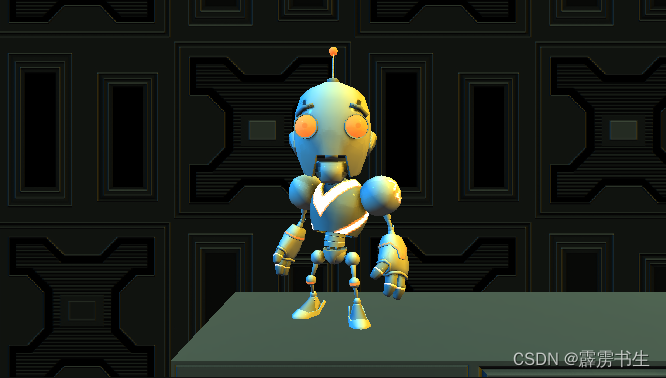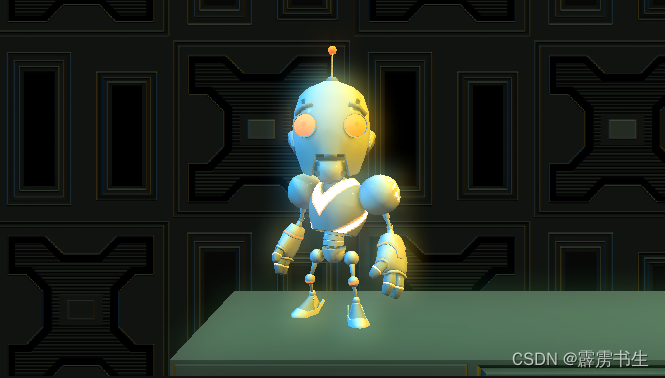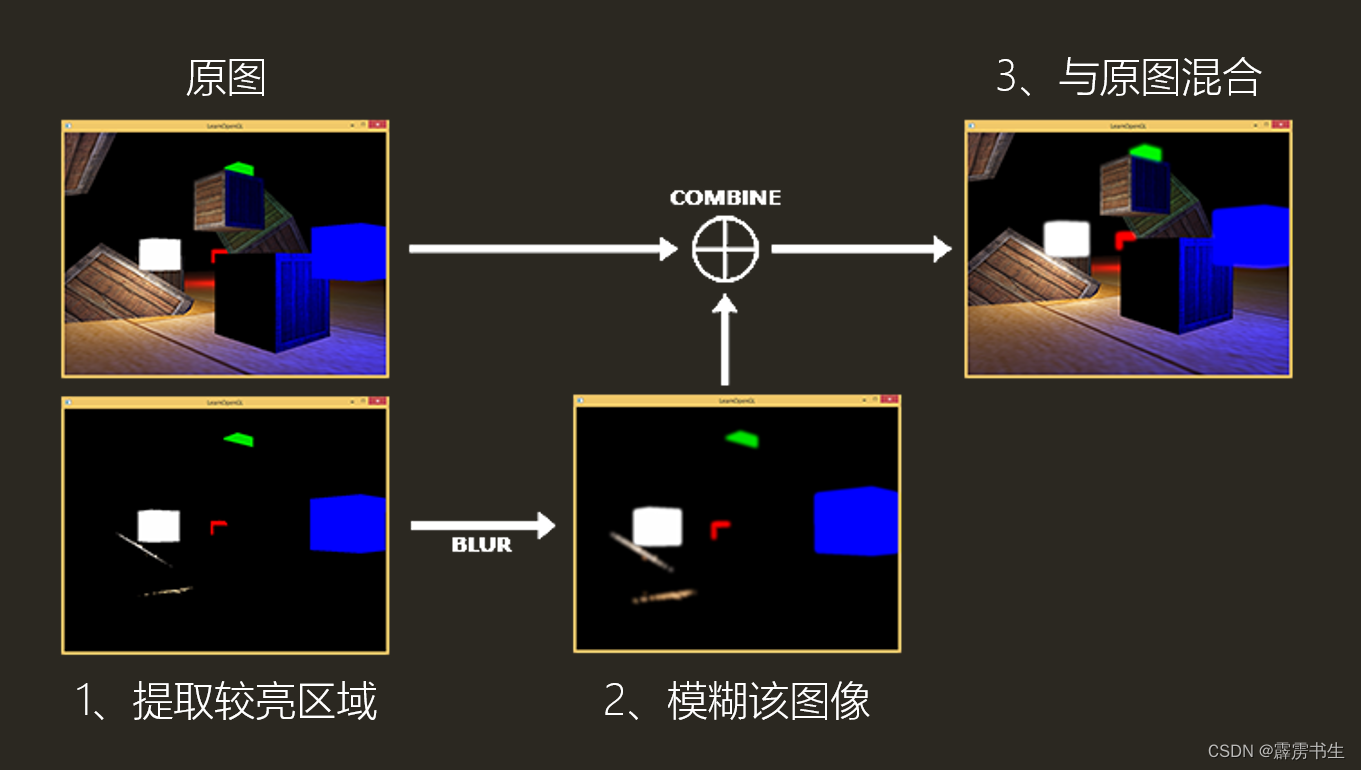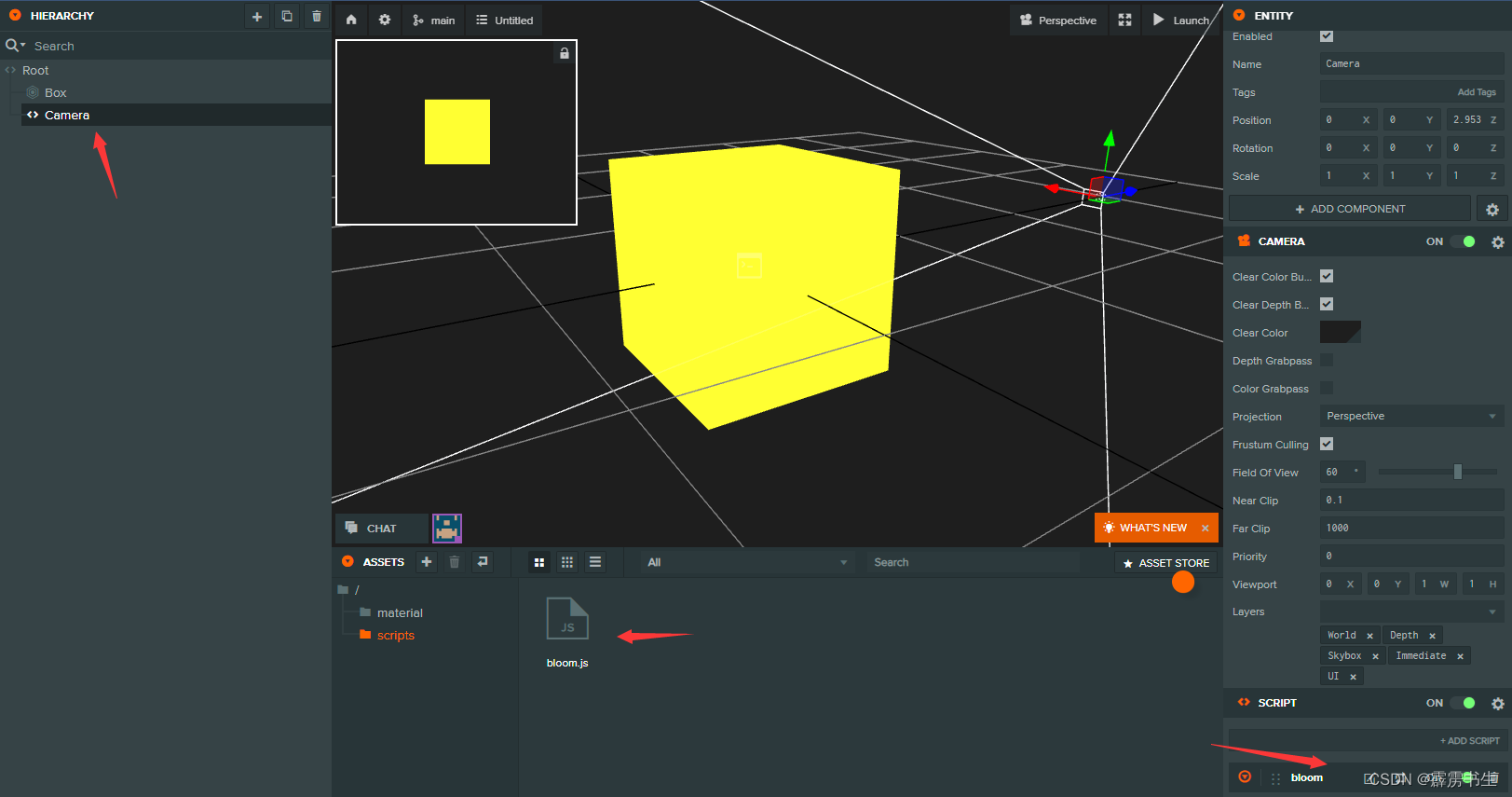(一)Bloom介绍
Bloom(辉光、光晕、泛光)是一种常见的摄像机后处理(PostProcessing)效果,用于再现真实世界相机的成像伪影。这种效果会产生从图像中明亮区域边界延伸的光条纹(或羽毛),从而产生一种极其明亮的光线压倒捕捉场景的相机的错觉。
辉光简单的说法,就是有些地方足够亮,看上去是溢出到周围的区域,下面是playcanvas官方提供的辉光效果对比图

图1 未使用辉光效果

图2 使用辉光效果
(二)Bloom实现原理

bloom的实现原理很简单:就是取camera获取图像的高亮部分,进行高斯模糊,并和原图进行合并就可以实现。
1. 提取较亮区域
通过阈值提取较亮区域的像素点
varying vec2 vUv0;
uniform sampler2D uBaseTexture
uniform float uBloomThreshold;
float luminance(vec4 color)
{
return 0.2125 * color[0] + 0.7154 * color[1] + 0.0721 * color[2];
}
void main(void)
{
vec4 color = texture2D(uBaseTexture, vUv0);
// 只保留亮度超过阈值亮度的像素点
float val = clamp(luminance(color) - uBloomThreshold, 0.0, 1.0);
gl_FragColor = color * val;
//这是playcanvas官网提供提取亮度高于某个阈值的算法,但还不知道它的原理
//gl_FragColor = clamp((color - uBloomThreshold) / (1.0 - uBloomThreshold), 0.0, 1.0);
}2. 高斯模糊
接下来,就是如何得到模糊图uBloomTexture
一般模糊图像的算法,我们可以选择常见的高斯模糊,它可以减少图像噪声、降低细节层次
高斯模糊的实现原理,这里不做多赘述,这里提供2篇文章供参考。
参考第二篇文章,我们在JavaScript中,计算我们高斯卷积核的权重和位移
var SAMPLE_COUNT = 15;
//高斯曲线
function computeGaussian(n, theta) {
return ((1.0 / Math.sqrt(2 * Math.PI * theta)) * Math.exp(-(n * n) / (2 * theta * theta)));
}
function calculateBlurValues(sampleWeights, sampleOffsets, dx, dy, blurAmount) {
// Create temporary arrays for computing our filter settings.
// The first sample always has a zero offset.
sampleWeights[0] = computeGaussian(0, blurAmount);
sampleOffsets[0] = 0;
sampleOffsets[1] = 0;
// Maintain a sum of all the weighting values.
var totalWeights = sampleWeights[0];
// Add pairs of additional sample taps, positioned
// along a line in both directions from the center.
var i, len;
for (i = 0, len = Math.floor(SAMPLE_COUNT / 2); i < len; i++) {
// Store weights for the positive and negative taps.
var weight = computeGaussian(i + 1, blurAmount);
sampleWeights[i * 2] = weight;
sampleWeights[i * 2 + 1] = weight;
totalWeights += weight * 2;
var sampleOffset = i * 2 + 1.5;
sampleOffsets[i * 4] = dx * sampleOffset;
sampleOffsets[i * 4 + 1] = dy * sampleOffset;
sampleOffsets[i * 4 + 2] = -dx * sampleOffset;
sampleOffsets[i * 4 + 3] = -dy * sampleOffset;
}
// Normalize the list of sample weightings, so they will always sum to one.
for (i = 0, len = sampleWeights.length; i < len; i++) {
sampleWeights[i] /= totalWeights;
}
}在fragment shader中,对图像进行卷积模糊(注意:这里的shader只对水平或垂直一个方向卷积)
#define SAMPLE_COUNT 15
varying vec2 vUv0;
uniform sampler2D uBloomTexture;
uniform vec2 uBlurOffsets[15];
uniform float uBlurWeights[15];
void main(void)
{
vec4 color = vec4(0.0);
for (int i = 0; i < SAMPLE_COUNT; i++)
{
color += texture2D(uBloomTexture, vUv0 + uBlurOffsets[i]) * uBlurWeights[i];
}
gl_FragColor = color;
} 最后,我们需要进行2次方向的滤波处理
原理具体参考文章二中,如何将高斯滤波器分为水平方向和垂直方向的滤波器的原理
// Pass 2: draw from rendertarget 1 into rendertarget 2(垂直方向)
calculateBlurValues(this.sampleWeights, this.sampleOffsets, 1.0 / this.targets[1].width, 0, this.blurAmount);
scope.resolve("uBlurWeights[0]").setValue(this.sampleWeights);
scope.resolve("uBlurOffsets[0]").setValue(this.sampleOffsets);
scope.resolve("uBloomTexture").setValue(this.targets[0].colorBuffer);
this.drawQuad(this.targets[1], this.blurShader);
// Pass 3: draw from rendertarget 2 back into rendertarget 1(水平方向)
calculateBlurValues(this.sampleWeights, this.sampleOffsets, 0, 1.0 / this.targets[0].height, this.blurAmount);
scope.resolve("uBlurWeights[0]").setValue(this.sampleWeights);
scope.resolve("uBlurOffsets[0]").setValue(this.sampleOffsets);
scope.resolve("uBloomTexture").setValue(this.targets[1].colorBuffer);
this.drawQuad(this.targets[0], this.blurShader);3. 混合原图和模糊图
那我们最后的fragment shader就可以这样实现,原图+模糊图进行混合
varying vec2 vUv0;
//bloom 强度
uniform float uBloomEffectIntensity;
uniform sampler2D uBaseTexture;
uniform sampler2D uBloomTexture;
void main(void)
{
vec4 bloom = texture2D(uBloomTexture, vUv0) * uBloomEffectIntensity;
vec4 base = texture2D(uBaseTexture, vUv0);
//将原图变暗,防止两图叠加后,像素溢出1
base *= (1.0 - clamp(bloom, 0.0, 1.0));
//合并原图和模糊图,得到最终的bloom效果
gl_FragColor = base + bloom;
}(三)在playcanvas编辑器中使用
1. 创建脚本bloom.js
// --------------- POST EFFECT DEFINITION --------------- //
var SAMPLE_COUNT = 15;
function computeGaussian(n, theta) {
return ((1.0 / Math.sqrt(2 * Math.PI * theta)) * Math.exp(-(n * n) / (2 * theta * theta)));
}
function calculateBlurValues(sampleWeights, sampleOffsets, dx, dy, blurAmount) {
// Look up how many samples our gaussian blur effect supports.
// Create temporary arrays for computing our filter settings.
// The first sample always has a zero offset.
sampleWeights[0] = computeGaussian(0, blurAmount);
sampleOffsets[0] = 0;
sampleOffsets[1] = 0;
// Maintain a sum of all the weighting values.
var totalWeights = sampleWeights[0];
// Add pairs of additional sample taps, positioned
// along a line in both directions from the center.
var i, len;
for (i = 0, len = Math.floor(SAMPLE_COUNT / 2); i < len; i++) {
// Store weights for the positive and negative taps.
var weight = computeGaussian(i + 1, blurAmount);
sampleWeights[i * 2] = weight;
sampleWeights[i * 2 + 1] = weight;
totalWeights += weight * 2;
// To get the maximum amount of blurring from a limited number of
// pixel shader samples, we take advantage of the bilinear filtering
// hardware inside the texture fetch unit. If we position our texture
// coordinates exactly halfway between two texels, the filtering unit
// will average them for us, giving two samples for the price of one.
// This allows us to step in units of two texels per sample, rather
// than just one at a time. The 1.5 offset kicks things off by
// positioning us nicely in between two texels.
var sampleOffset = i * 2 + 1.5;
// Store texture coordinate offsets for the positive and negative taps.
sampleOffsets[i * 4] = dx * sampleOffset;
sampleOffsets[i * 4 + 1] = dy * sampleOffset;
sampleOffsets[i * 4 + 2] = -dx * sampleOffset;
sampleOffsets[i * 4 + 3] = -dy * sampleOffset;
}
// Normalize the list of sample weightings, so they will always sum to one.
for (i = 0, len = sampleWeights.length; i < len; i++) {
sampleWeights[i] /= totalWeights;
}
}
/**
* @class
* @name BloomEffect
* @classdesc Implements the BloomEffect post processing effect.
* @description Creates new instance of the post effect.
* @augments PostEffect
* @param {GraphicsDevice} graphicsDevice - The graphics device of the application.
* @property {number} bloomThreshold Only pixels brighter then this threshold will be processed. Ranges from 0 to 1.
* @property {number} blurAmount Controls the amount of blurring.
* @property {number} bloomIntensity The intensity of the effect.
*/
function BloomEffect(graphicsDevice) {
pc.PostEffect.call(this, graphicsDevice);
// Shaders
var attributes = {
aPosition: pc.SEMANTIC_POSITION
};
// Pixel shader extracts the brighter areas of an image.
// This is the first step in applying a bloom postprocess.
var extractFrag = [
"varying vec2 vUv0;",
"",
"uniform sampler2D uBaseTexture;",
"uniform float uBloomThreshold;",
"",
"float luminance(vec4 color)",
"{",
" return 0.2125 * color[0] + 0.7154 * color[1] + 0.0721 * color[2]; ",
"}",
"",
"void main(void)",
"{",
// Look up the original image color.
" vec4 color = texture2D(uBaseTexture, vUv0);",
"",
// Adjust it to keep only values brighter than the specified threshold.
" float val = clamp(luminance(color) - uBloomThreshold, 0.0, 1.0);",
" gl_FragColor = color * val;",
"}"
].join("\n");
// Pixel shader applies a one dimensional gaussian blur filter.
// This is used twice by the bloom postprocess, first to
// blur horizontally, and then again to blur vertically.
var gaussianBlurFrag = [
"#define SAMPLE_COUNT " + SAMPLE_COUNT,
"",
"varying vec2 vUv0;",
"",
"uniform sampler2D uBloomTexture;",
"uniform vec2 uBlurOffsets[" + SAMPLE_COUNT + "];",
"uniform float uBlurWeights[" + SAMPLE_COUNT + "];",
"",
"void main(void)",
"{",
" vec4 color = vec4(0.0);",
// Combine a number of weighted image filter taps.
" for (int i = 0; i < SAMPLE_COUNT; i++)",
" {",
" color += texture2D(uBloomTexture, vUv0 + uBlurOffsets[i]) * uBlurWeights[i];",
" }",
"",
" gl_FragColor = color;",
"}"
].join("\n");
// Pixel shader combines the bloom image with the original
// scene, using tweakable intensity levels.
// This is the final step in applying a bloom postprocess.
var combineFrag = [
"varying vec2 vUv0;",
"",
"uniform float uBloomEffectIntensity;",
"uniform sampler2D uBaseTexture;",
"uniform sampler2D uBloomTexture;",
"",
"void main(void)",
"{",
// Look up the bloom and original base image colors.
" vec4 bloom = texture2D(uBloomTexture, vUv0) * uBloomEffectIntensity;",
" vec4 base = texture2D(uBaseTexture, vUv0);",
"",
// Darken down the base image in areas where there is a lot of bloom,
// to prevent things looking excessively burned-out.
" base *= (1.0 - clamp(bloom, 0.0, 1.0));",
"",
// Combine the two images.
" gl_FragColor = base + bloom;",
"}"
].join("\n");
this.extractShader = pc.createShaderFromCode(graphicsDevice, pc.PostEffect.quadVertexShader, extractFrag, 'BloomExtractShader', attributes);
this.blurShader = pc.createShaderFromCode(graphicsDevice, pc.PostEffect.quadVertexShader, gaussianBlurFrag, 'BloomBlurShader', attributes);
this.combineShader = pc.createShaderFromCode(graphicsDevice, pc.PostEffect.quadVertexShader, combineFrag, 'BloomCombineShader', attributes);
this.targets = [];
// Effect defaults
this.bloomThreshold = 0.25;
this.blurAmount = 4;
this.bloomIntensity = 1.25;
// Uniforms
this.sampleWeights = new Float32Array(SAMPLE_COUNT);
this.sampleOffsets = new Float32Array(SAMPLE_COUNT * 2);
}
BloomEffect.prototype = Object.create(pc.PostEffect.prototype);
BloomEffect.prototype.constructor = BloomEffect;
BloomEffect.prototype._destroy = function () {
if (this.targets) {
var i;
for (i = 0; i < this.targets.length; i++) {
this.targets[i].destroyTextureBuffers();
this.targets[i].destroy();
}
}
this.targets.length = 0;
};
BloomEffect.prototype._resize = function (target) {
var width = target.colorBuffer.width;
var height = target.colorBuffer.height;
if (width === this.width && height === this.height)
return;
this.width = width;
this.height = height;
this._destroy();
// Render targets
var i;
for (i = 0; i < 2; i++) {
var colorBuffer = new pc.Texture(this.device, {
name: "Bloom Texture" + i,
format: pc.PIXELFORMAT_RGBA8,
width: width >> 1,
height: height >> 1,
mipmaps: false
});
colorBuffer.minFilter = pc.FILTER_LINEAR;
colorBuffer.magFilter = pc.FILTER_LINEAR;
colorBuffer.addressU = pc.ADDRESS_CLAMP_TO_EDGE;
colorBuffer.addressV = pc.ADDRESS_CLAMP_TO_EDGE;
colorBuffer.name = 'pe-bloom-' + i;
var bloomTarget = new pc.RenderTarget({
name: "Bloom Render Target " + i,
colorBuffer: colorBuffer,
depth: false
});
this.targets.push(bloomTarget);
}
};
Object.assign(BloomEffect.prototype, {
render: function (inputTarget, outputTarget, rect) {
this._resize(inputTarget);
var device = this.device;
var scope = device.scope;
// Pass 1: draw the scene into rendertarget 1, using a
// shader that extracts only the brightest parts of the image.
scope.resolve("uBloomThreshold").setValue(this.bloomThreshold);
scope.resolve("uBaseTexture").setValue(inputTarget.colorBuffer);
this.drawQuad(this.targets[0], this.extractShader);
// Pass 2: draw from rendertarget 1 into rendertarget 2,
// using a shader to apply a horizontal gaussian blur filter.
calculateBlurValues(this.sampleWeights, this.sampleOffsets, 1.0 / this.targets[1].width, 0, this.blurAmount);
scope.resolve("uBlurWeights[0]").setValue(this.sampleWeights);
scope.resolve("uBlurOffsets[0]").setValue(this.sampleOffsets);
scope.resolve("uBloomTexture").setValue(this.targets[0].colorBuffer);
this.drawQuad(this.targets[1], this.blurShader);
// Pass 3: draw from rendertarget 2 back into rendertarget 1,
// using a shader to apply a vertical gaussian blur filter.
calculateBlurValues(this.sampleWeights, this.sampleOffsets, 0, 1.0 / this.targets[0].height, this.blurAmount);
scope.resolve("uBlurWeights[0]").setValue(this.sampleWeights);
scope.resolve("uBlurOffsets[0]").setValue(this.sampleOffsets);
scope.resolve("uBloomTexture").setValue(this.targets[1].colorBuffer);
this.drawQuad(this.targets[0], this.blurShader);
// Pass 4: draw both rendertarget 1 and the original scene
// image back into the main backbuffer, using a shader that
// combines them to produce the final bloomed result.
scope.resolve("uBloomEffectIntensity").setValue(this.bloomIntensity);
scope.resolve("uBloomTexture").setValue(this.targets[0].colorBuffer);
scope.resolve("uBaseTexture").setValue(inputTarget.colorBuffer);
this.drawQuad(outputTarget, this.combineShader, rect);
}
});
// ----------------- SCRIPT DEFINITION ------------------ //
var Bloom = pc.createScript('bloom');
Bloom.attributes.add('bloomIntensity', {
type: 'number',
default: 1,
min: 0,
title: 'Intensity'
});
Bloom.attributes.add('bloomThreshold', {
type: 'number',
default: 0.25,
min: 0,
max: 1,
title: 'Threshold'
});
Bloom.attributes.add('blurAmount', {
type: 'number',
default: 4,
min: 1,
'title': 'Blur amount'
});
Bloom.prototype.initialize = function () {
this.effect = new BloomEffect(this.app.graphicsDevice);
this.effect.bloomThreshold = this.bloomThreshold;
this.effect.blurAmount = this.blurAmount;
this.effect.bloomIntensity = this.bloomIntensity;
var queue = this.entity.camera.postEffects;
queue.addEffect(this.effect);
this.on('attr', function (name, value) {
this.effect[name] = value;
}, this);
this.on('state', function (enabled) {
if (enabled) {
queue.addEffect(this.effect);
} else {
queue.removeEffect(this.effect);
}
});
this.on('destroy', function () {
queue.removeEffect(this.effect);
this.effect._destroy();
});
};2. 将脚本挂载在相机























 419
419











 被折叠的 条评论
为什么被折叠?
被折叠的 条评论
为什么被折叠?








